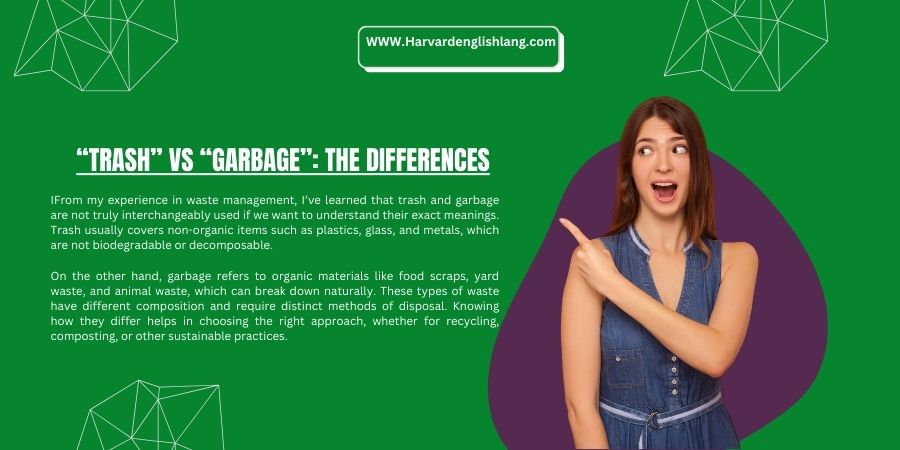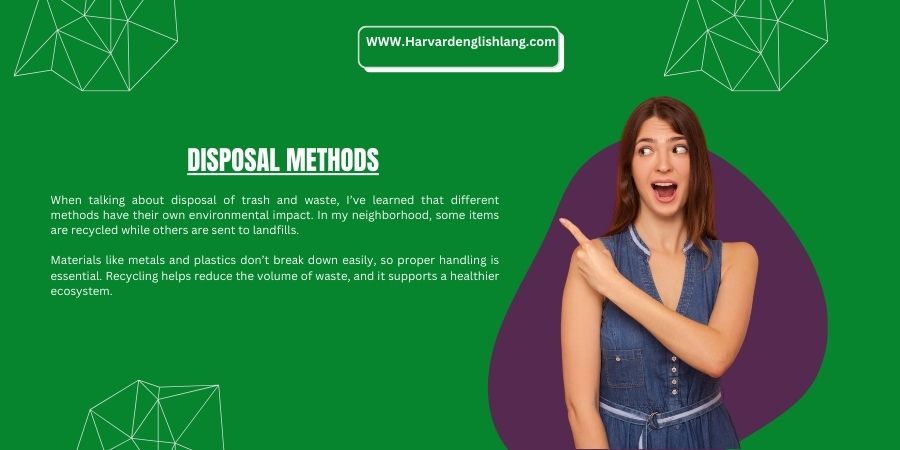In my work with waste management, I often meet people who are curious about the differences between trash and garbage, yet many use these terms interchangeably in everyday words and conversations.
This article aims to explore these subtle distinctions and discover why they matter in our daily lives. From my own thought and professional experience, I’ve learned that knowing the precise meaning of each can help you communicate more accurately when discussing waste.
Over time, paying attention to such small details can lead to better habits and a clearer understanding of how language shapes our perspective on the materials we discard.
What is “Trash”?
From years of sorting waste at home and helping in community clean-up drives, I’ve noticed how each type of waste has its own quirks and challenges. Here are five examples that show the variety of materials we deal with:
- Paper Products: like newspapers and magazines are often useful when reused but too often get thrown away instead of being recycled.
- Plastic Items: such as bottles, bags, and food wrappers are a major part of the waste we see in landfills, where they can take a long time to decompose.
- Glass materials:, from jars to broken bottles and glassware, are durable but require proper disposal to avoid injuries and support recycling efforts.
- Metal waste:, including cans, foil, and scrap metal, is highly recyclable, yet often mixed with non-organic materials, making management harder.
- Miscellaneous Items: like furniture, toys, electronics, and worn-out household goods encompass a wide range of non-perishable items that, if discarded carelessly, increase environmental impact instead of promoting reuse.
You Might Also like: What Kind of vs What Kinds of: Clear Your Doubts Fast!
What is “Garbage”?
In my years of home composting and community clean-up events, I’ve learned how different kinds of organic waste can be managed for a more sustainable lifestyle. Here are five examples that show the range of materials we deal with daily:
- Vegetable peels, fruit rinds, and food scraps from cooking can be composted to make valuable fertilizer for plants.
- Leftover food, bread, and moldy cheese are common items that, if disposed of properly, can help in waste reduction.
- Yard waste such as grass clippings, leaves, and branches can decompose naturally, reducing the tendency to produce unpleasant odors.
- Organic kitchen waste like coffee grounds, eggshells, and tea bags can be turned into rich compost, making them a valuable part of living more sustainably.
- Spoiled food, expired goods, and other common waste from animals or vegetables often make great compost when managed with the right practices and efforts.
“Trash” vs “Garbage”: The Differences

From my experience in waste management, I’ve learned that trash and garbage are not truly interchangeably used if we want to understand their exact meanings. Trash usually covers non-organic items such as plastics, glass, and metals, which are not biodegradable or decomposable.
On the other hand, garbage refers to organic materials like food scraps, yard waste, and animal waste, which can break down naturally. These types of waste have different composition and require distinct methods of disposal. Knowing how they differ helps in choosing the right approach, whether for recycling, composting, or other sustainable practices.
Type of Waste
From my own experience in sorting waste at home, I’ve seen how it includes both non-organic and organic materials, each with its own handling needs. Non-biodegradable items like glass, plastics, and metals don’t decompose naturally and require proper recycling methods.
On the other hand, organic waste, such as vegetable peels and fruit scraps, is biodegradable and can turn into compost.
- Food scraps, spoiled food, and yard waste can be composted to reduce landfill impact.
- Old toys, broken electronics, and paper packaging are common non-biodegradable items that need recycling instead of disposal.
Disposal Methods

When talking about disposal of trash and waste, I’ve learned that different methods have their own environmental impact. In my neighborhood, some items are recycled while others are sent to landfills.
Materials like metals and plastics don’t break down easily, so proper handling is essential. Recycling helps reduce the volume of waste, and it supports a healthier ecosystem.
Environmental Impact
- Trash: Recycling plastics and metals prevents pollutants from overflowing landfills.
- Garbage: Composting food scraps correctly produces organic matter that benefits plants and soil.
Common Usage
- Trash: Throwing away old plastic bottles and papers is considered Trash.
- Garbage: Peels from fruits and leftover food are Garbage because they decompose naturally.
| Aspect | Trash | Garbage |
| Type of Waste | Non-organic, non-biodegradable, plastics, metals, glass, paper, items, recyclable, non-recyclable | Organic, biodegradable, food scraps, yard waste, spoiled food, plant, nutrients, decomposable, naturally |
| Disposal Method | Typically sent, landfills, recycling, overflow | Can be composted, composting, enriches soil, supports growth |
| Environmental Impact | Persists, contributes to pollution, impact lasts years, reduces recyclable efficiency | Reduces waste, recycles nutrients, benefits soil, supports plant growth |
| Inclusion | Includes items, plastics, metals, paper | Specifically refers to organic, food scraps, yard waste, spoiled food |
Origins of the Words “Trash” and “Garbage”
Origins of the Word “Trash”
The term trash dates back to the 1400s, originating from Old Norse tros and Norwegian trask, referring to rubbish, lumber, fallen leaves, brush, and twigs used as kindling.
Over centuries, the evolution of the word in English expanded its application to a broad range of items and materials, including non-organic, non-biodegradable plastics, metals, paper, and other kinds of waste that were discarded or broken. Its roots highlight the value people once placed on reusable materials while distinguishing trash from other types of refuse.
You Might Also like: How Are You Fairing or Faring? Uncover the Truth
Origins of the Word “Garbage”
The word Garbage originated in the early 15th century, initially referring to parts of animals like giblets and offal used during preparation in the kitchen. This term likely evolved from Anglo-French contexts and usage, and by the late 16th century, it expanded to denote any kind of refuse or filth, including vegetable and organic food scraps.
Over time, its transformation reflects changes in waste management practices, the types of materials used, and the ways discarded items naturally decomposes, encompassing both biodegradable and non-biodegradable waste.
Conclusion
Understanding the main differences between Trash and Garbage helps people communicate more clearly and effectively.
Trash usually refers to non-organic items like plastics and metals that don’t decompose, while Garbage means organic waste such as food scraps that decomposes naturally. Knowing these terms includes recognizing that junk and British rubbish are sometimes used interchangeably, though they cover different types of waste.
This understanding makes it easier to use, write about, and handle valuable items correctly, ensuring no longer useful things are sorted properly and useful materials are recycled.

A communication coach with a background in public speaking and business English. He helps professionals refine their English for workplace success.
